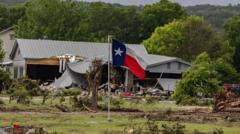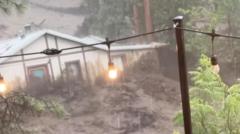The recent floods in Valencia have resulted in a staggering death toll exceeding 200, particularly impacting the town of Paiporta, which recorded at least 62 fatalities. Factors contributing to this tragedy include drivers stuck in vehicles, inadequate planning, and climate-induced extreme rainfall. An emergency alert was issued too late, leaving residents vulnerable as floodwaters rapidly rose. Eyewitness accounts reveal harrowing scenes of those stranded in their cars and the dire consequences of being trapped in garages. Experts also highlight the role of rampant development and climate change in exacerbating the flood's severity, prompting urgent calls for reassessment and improved preparedness moving forward.
Tragedy in Valencia: The Deadly Impact of Flash Floods

Tragedy in Valencia: The Deadly Impact of Flash Floods
In the aftermath of devastating flash floods, Valencia faces critical questions about emergency responses and planning failures.
The date was October 2023, and Spain was grappling with the aftermath of severe flash floods that struck the region, resulting in significant loss of life and highlighting crucial shortcomings in local emergency preparedness. The south-eastern part of the country, particularly the metropolitan area of Valencia, was hardest hit, with many residents finding themselves caught in a nightmare as floodwaters surged unexpectedly.
In the beleaguered town of Paiporta, with a population of 25,000, the devastation was particularly acute, with local reports indicating up to 62 fatalities. This overwhelming death toll raises alarms and leads to a critical examination of why so many lives were lost when emergency systems were in place to avert such tragedies.
One significant factor was the timing of the emergency alerts from the civil protection agency, which notified residents only after floodwaters had already begun to wreak havoc. Many individuals, including workers returning home, were caught off guard, unable to navigate the dangers posed by sudden flooding. It became increasingly clear that many victims had been trapped in their vehicles, especially as torrential rains transformed roads into fast-moving torrents.
Local leaders, such as Paiporta’s Mayor Maribel Albalat, expressed concerns over the town's preparedness and laid blame on the lack of necessary infrastructure to combat flooding. Many buildings, including ground-floor flats and elderly care homes, were particularly vulnerable, with scores of lives lost as floodwaters poured in.
Witness accounts revealed chilling scenarios, including a man attempting to tether himself to a lamppost to avoid being swept away. As rescue teams comb through the aftermath, officials warn that numerous vehicles remain overturned and could still harbor more victims.
Environmental factors further complicate the disaster’s narrative. Increased urbanization, reduced absorption capacity of the soil due to insufficient rainfall, and the impacts of global climate change have all intensified the predicament. Experts argue this tragic incident could serve as a sobering wake-up call, underscoring the urgent need for better infrastructure, planning, and community awareness to mitigate future flood risks.
As Spain mourns, the lessons learned from this catastrophic event emphasize the necessity of preparedness, resilience, and proactive measures in the face of climate challenges, ensuring that such loss of life is never repeated.
Valencia grapples with the aftermath of catastrophic flooding as it searches for answers.
In the beleaguered town of Paiporta, with a population of 25,000, the devastation was particularly acute, with local reports indicating up to 62 fatalities. This overwhelming death toll raises alarms and leads to a critical examination of why so many lives were lost when emergency systems were in place to avert such tragedies.
One significant factor was the timing of the emergency alerts from the civil protection agency, which notified residents only after floodwaters had already begun to wreak havoc. Many individuals, including workers returning home, were caught off guard, unable to navigate the dangers posed by sudden flooding. It became increasingly clear that many victims had been trapped in their vehicles, especially as torrential rains transformed roads into fast-moving torrents.
Local leaders, such as Paiporta’s Mayor Maribel Albalat, expressed concerns over the town's preparedness and laid blame on the lack of necessary infrastructure to combat flooding. Many buildings, including ground-floor flats and elderly care homes, were particularly vulnerable, with scores of lives lost as floodwaters poured in.
Witness accounts revealed chilling scenarios, including a man attempting to tether himself to a lamppost to avoid being swept away. As rescue teams comb through the aftermath, officials warn that numerous vehicles remain overturned and could still harbor more victims.
Environmental factors further complicate the disaster’s narrative. Increased urbanization, reduced absorption capacity of the soil due to insufficient rainfall, and the impacts of global climate change have all intensified the predicament. Experts argue this tragic incident could serve as a sobering wake-up call, underscoring the urgent need for better infrastructure, planning, and community awareness to mitigate future flood risks.
As Spain mourns, the lessons learned from this catastrophic event emphasize the necessity of preparedness, resilience, and proactive measures in the face of climate challenges, ensuring that such loss of life is never repeated.
Valencia grapples with the aftermath of catastrophic flooding as it searches for answers.






















